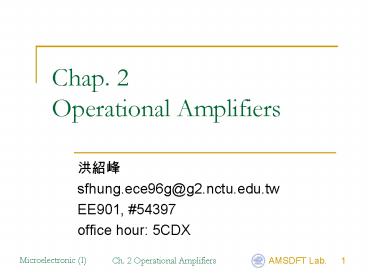Chap' 2 Operational Amplifiers - PowerPoint PPT Presentation
1 / 20
Title:
Chap' 2 Operational Amplifiers
Description:
The circuit is frequently used to provide an output voltage vo proportional to ... ZL with a current proportional to vI and independent of the value of ZL. ... – PowerPoint PPT presentation
Number of Views:76
Avg rating:3.0/5.0
Title: Chap' 2 Operational Amplifiers
1
Chap. 2Operational Amplifiers
- ???
- sfhung.ece96g_at_g2.nctu.edu.tw
- EE901, 54397
- office hour 5CDX
2
Ideal OP Amplifier
- Input impedance Ri ? 8
- Input current i1 i2 ? 0
- Output impedance Ro ? 0
- Common-mode gain Acm ? 0
- CMRR ? 8
- Open-loop gain A ? 8
- v1 v2 are virtual short
- Bandwidth ? 8
3
Differential and Common-Mode Signals
- Define
- then
4
Inverting Configuration
- Open-loop gain A is infinite
5
Inverting Configuration
- Open-loop gain A is finite
- If A ? 8,
6
Noninverting Configuration
- Open-loop gain A is infinite
7
Voltage Follower
- Unit-gain amplifier
8
Exercises 2.9
- Use the superposition principle to find the
output voltage.
9
Difference Amplifiers
- For practical circuits
- Ad differential gain
- Acm common-mode gain
- Common-mode rejection ratio (CMRR)
10
Problem 2.2
- The circuit uses an op amp that is ideal except
for having a finite gain A. Measurements indicate
vo4.0V when vi4.0V. What is the op amp gain A?
vo/A
11
Problem 2.8
- Assuming ideal op amps, find the voltage gain
vo/vi and input resistance Rin of each circuit.
inverting
0V
0V
12
Problem 2.22
- The circuit is frequently used to provide an
output voltage vo proportional to an input signal
current ii. Derive expressions for the
transresistance Rmvo/ii and the input resistance
Rivi/ii for (a) A is infinite(b) A is finite
-vo/A
0V
13
Problem 2.31
- (a) Find the resistances R1, R2, R3, and R4.(b)
Find the currents I1, I2, I3, and I4 in terms of
the input current I.(c) Find the voltages in
terms of (IR).
-4IR
-2IR
-IR
-8IR
14
Problem 2.49
- Derive an expression for the voltage gain, vo/vi.
noninverting
15
Problem 2.51
- The circuit utilizes a 10-kO potentiometer to
realize an adjustable-gain amplifier. (a) Derive
an expression for the gain as a function of the
potentiometer setting x. (b) Assume the op amp
to be ideal. What is the range of gains obtained?
(c) Show how to add a fixed resistor so that the
gain range can be 1 to 21 V/V. What should the
resistor value be?
noninverting
16
Problem 2.62
- (a) Express vo as a function of v1 and v2. (b)
What is the input resistance seen - by v1 alone?
- by v2 alone?
- by a source connected between the two input
terminals? - by a source connected to both input terminals
simultaneously?
17
Problem 2.62
- (a) Express vo as a function of v1 and v2.
By superposition
v2/2
0V
18
Problem 2.62
- (b) What is the input resistance seen
- by v1 alone?
- by v2 alone?
- by a source connected between the two input
terminals? - by a source connected to both input terminals
simultaneously?
0V
vi/2
19
Problem 2.70
- The circuit is a modified version of the
difference amplifier. The modified circuit
includes a resistor RG, which can be used to vary
the gain. Show that the differential voltage gain
is given by
20
Problem 2.78
- The two circuits are intended to function as
voltage-to-current converters that is, they
supply the load impedance ZL with a current
proportional to vI and independent of the value
of ZL. Show that this is indeed the case, and
find for each circuit iO as a function of vI.
Comment on the differences between the two
circuits.
v1
-v2
ZLio

